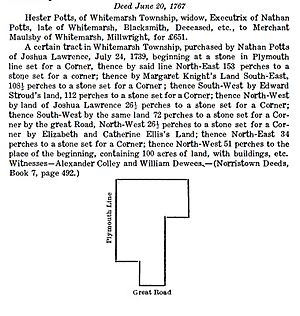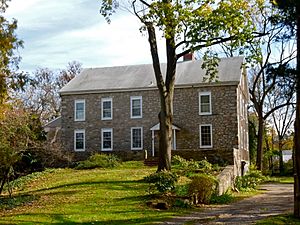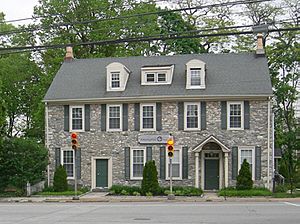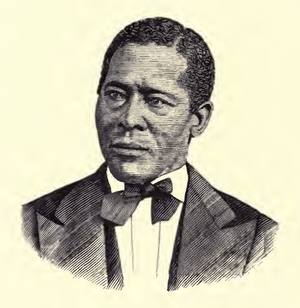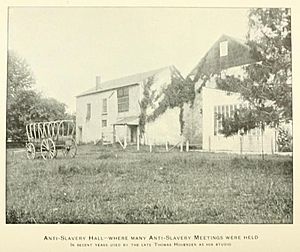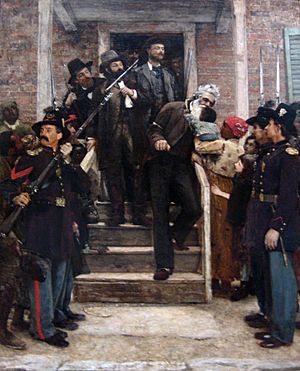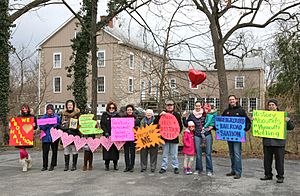Hovenden House, Barn and Abolition Hall facts for kids
|
Hovenden House, Barn and Abolition Hall
|
|
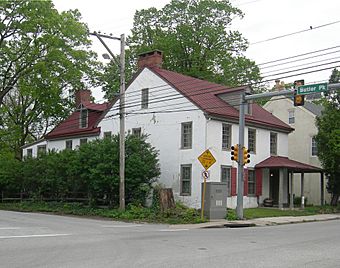
Maulsby-Corson-Hovenden House, built c.1795.
|
|
| Location | 1 E. Germantown Pike, Plymouth Meeting, Whitemarsh Township, Pennsylvania |
|---|---|
| Area | 9 acres (3.6 ha) |
| Built | c.1795, 1856 |
| Built by | Samuel Maulsby (house & barn) George Corson (Abolition Hall) |
| Architectural style | Federal |
| NRHP reference No. | 71000713 |
Quick facts for kids Significant dates |
|
| Added to NRHP | February 18, 1971 |
The Hovenden House, Barn and Abolition Hall are a group of old buildings in Plymouth Meeting, Pennsylvania. These buildings are very important because they played a big role in the Underground Railroad before the American Civil War. The Underground Railroad was a secret network that helped enslaved people escape to freedom.
Abolition Hall was built as a meeting place for people who wanted to end slavery, called abolitionists. Later, it became the art studio of a famous artist named Thomas Hovenden.
The Hovenden House is at the corner of Germantown and Butler Pikes. The stone barn is northeast of the house. Abolition Hall is a two-story building attached to the barn. These three buildings are part of a 10.45-acre farm. They are also part of the Plymouth Meeting Historic District.
Today, these historic buildings are at risk. There is a plan to change a road that would affect the Hovenden House and its barn. Because of this, the property was added to the 2017 Pennsylvania At Risk list.
Contents
History of the Hovenden Property
The area of Plymouth Meeting was settled by a group of Quakers from England in 1686. The Maulsby family, who became important later, arrived in Pennsylvania in 1698. They moved to Whitemarsh Township in 1705.
The Maulsby Family and Their Farm
Merchant Maulsby Jr. (1737–1772) was a mill builder. In 1767, he bought a 100-acre farm in the area. He and his wife built a stone house on the property.
When Samuel Maulsby, Merchant Jr.'s son, was 10 years old, he saw British soldiers march past his home in 1778. This happened during the American Revolutionary War. The soldiers were trying to surround the Marquis de Lafayette and his troops. Samuel later shared his memories of the soldiers taking things from his widowed mother's house.
In 1794, Samuel Maulsby bought more land, including the corner where the Hovenden House now stands. Around 1795, he built a large, three-story house on this corner. This house was built in the Federal style. He also built the stone barn and a carriage shed around the same time.
Samuel Maulsby also built the Plymouth Meeting General Store and Post Office around 1826-27. His son, Jonathan, ran the store and became the first postmaster of Plymouth Meeting.
In 1832, Samuel's daughter, Martha, married George Corson. After Samuel Maulsby died in 1838, George and Martha bought the farm. George and his brothers also bought the family's limestone quarries.
Abolitionism: Fighting for Freedom
The Fugitive Slave Act of 1793 made it a crime to help enslaved people who had escaped. Despite this, Samuel Maulsby and the Corson family were strong supporters of ending slavery.
Samuel Maulsby and the Corsons helped start the Plymouth Meeting Anti-Slavery Society in 1831. They also helped create the Montgomery County Anti-Slavery Society in 1837. These groups met to discuss how to end slavery. Famous abolitionists like Frederick Douglass spoke at some of these meetings.
George and Martha Corson became very active in the Underground Railroad. They turned their home into a major station. They provided food and a safe place for hundreds of enslaved people escaping to freedom. A free Black man named Daniel Ross often helped guide these people at night. He would lead them to the next safe house on their journey north. The route continued through Pennsylvania, New Jersey, and New York, eventually leading to freedom in Canada. Sometimes, George Corson even hid people under hay in his wagon to move them safely.
The Fugitive Slave Act of 1850 made it even harder to help escaped slaves. It increased the penalties and allowed slave catchers to pursue people across state lines. But George Corson continued his work.
The Story of Jane Johnson
On July 18, 1855, an enslaved woman named Jane Johnson and her two young sons arrived in Philadelphia. They were traveling with their enslaver, John H. Wheeler, who was a U.S. Ambassador. In Philadelphia, they had to switch to a ferry. Pennsylvania had laws against slavery, so Jane Johnson was legally free once she was in the state.
Jane Johnson wanted to be free. She got help from an abolitionist named William Still and a lawyer named Passmore Williamson. They met her on the ferry. Williamson explained that Pennsylvania law meant she was free if she chose to be. Jane bravely said she wanted her freedom.
William Still helped Jane and her sons leave the ferry. Five Black dockworkers prevented Wheeler from stopping them. Williamson stayed to explain that their actions were legal.
Williamson was later arrested, but he argued that Jane was not a "fugitive" because her enslaver brought her into a free state. William Still and the dockworkers were also accused of various actions. Jane Johnson appeared in court as a surprise witness. She testified that she had left Wheeler willingly. The serious accusations against the men were dropped.
After the trial, Jane Johnson was escorted out of the courthouse by important abolitionists, including Lucretia Mott and George Corson. She was hidden at Corson's house in Plymouth Meeting to keep her safe. George Corson's 13-year-old son, Ellwood, later drove Jane in a carriage to the next safe house. From there, she traveled to Boston and reunited with her sons.
Abolition Hall: A Place for Freedom Fighters
After the Jane Johnson case, the Plymouth Friends Meeting House stopped allowing anti-slavery meetings. In response, George Corson decided to build his own meeting place. In 1856, he built a lecture hall above his carriage shed. This building became known as Abolition Hall.
Abolition Hall could hold up to 200 people. It became a vital place for the Plymouth Meeting Anti-Slavery Society. Many famous abolitionists gave speeches there, including Frederick Douglass, Harriet Beecher Stowe, William Lloyd Garrison, and Lucretia Mott. They spoke out against slavery and inspired many people.
George Corson died in 1860. William Still praised him for his dedication to helping enslaved people. Still wrote that Corson's home was always open to those seeking freedom and to abolitionist speakers.
Artist's Studio: A New Chapter
George and Martha Corson's daughter, Helen (1846-1935), became an artist. She studied art in Philadelphia and Paris. In 1881, she married an Irish-born painter named Thomas Hovenden (1840-1895). They moved into her parents' house.
Thomas Hovenden turned Abolition Hall into his art studio. The history of the building, especially its connection to the fight against slavery, inspired some of his paintings. His most famous work is The Last Moments of John Brown (1882–84). This painting shows the abolitionist John Brown kissing a baby as he is led to his execution.
Thomas Hovenden tragically died in 1895 while trying to save a little girl from a train accident. Helen Corson Hovenden then worked to make train crossings safer.
Their daughter, Martha Maulsby Hovenden (1884-1941), also became a sculptor. She later used Abolition Hall as her studio, continuing the artistic legacy of the family.
Nancy Corson (1920-2012), a great-granddaughter of George Corson, lived in the Maulsby stone barn from 1946 until her death. Her grandfather, Dr. Ellwood M. Corson, was the teenager who helped Jane Johnson escape in 1855.
Plymouth Meeting Historic District and Preservation Efforts
The village of Plymouth Meeting was recognized as a Pennsylvania historic district in 1961. This meant that 66 historic buildings in the area were protected.
In 1971, Plymouth Meeting became Pennsylvania's first National Register District. At that time, the Hovenden House, Barn, and Abolition Hall were in danger. There was a plan to change a road that would have required tearing down Abolition Hall. Nancy Corson wrote a special request to protect these buildings, and it was approved in 1971. Because of this, the road plans were stopped.
Historical Marker for Abolition Hall
Nancy Corson and Charles L. Blockson, an expert on the Underground Railroad, worked together to get a historical marker for Abolition Hall. The marker was approved and placed in front of the barn on November 18, 2000. It tells visitors about the important history of Abolition Hall.
Recent History and Current Challenges
In 2014, the owners of the property turned down an offer from Whitemarsh Township to buy the land for open space.
Proposed Development Threatens History
In late 2015, a building company proposed building 48 townhouses on the land behind the historic buildings. This plan also included moving Butler Pike between the Hovenden House and the Barn/Abolition Hall. This road change would mean tearing down or moving the Plymouth Meeting General Store and Post Office, which is also a historic building.
Many people spoke out against this plan. The Whitemarsh Township Board of Supervisors voted against the company's request to change the zoning rules. The building company then submitted a new plan.
Local residents and groups are fighting to protect these historic buildings. They have filed appeals and are challenging the development plans.
Advocacy to Save the Site
In 2016, the Preservation Alliance for Greater Philadelphia added Abolition Hall and the Hovenden House to its "Places to Save" list. This list highlights important places that are at risk.
In 2017, Preservation Pennsylvania also added the property to its 2017 Pennsylvania At Risk List. This organization is helping a group called "Friends of Abolition Hall" raise money to support the legal fight to protect the homestead. You can find more information and support their efforts online.
The fight to save the Corson homestead continues. The Friends of Abolition Hall are challenging the developer's plans. They argue that the proposed townhouse plan does not meet the necessary rules. Public hearings are ongoing to decide the future of this important historic site.
Media Coverage
Many news outlets have covered the story of the Hovenden House, Barn, and Abolition Hall.
Television
- "Battle over Montco's ties to the Underground Railroad," NBC10, Philadelphia, May 7, 2016. This report showed tunnels in the cellar of the Plymouth Meeting Country Store, which some believe were part of the Underground Railroad.
Newspapers
- "Plymouth Meeting Quakers hid slaves – It's a shrine of the Underground Railroad," The Philadelphia Inquirer, June 19, 1995.
- "Historical marker for a carriage shed called Abolition Hall," The Philadelphia Inquirer, December 10, 2000.
- "An underground story no more," The Philadelphia Inquirer, December 14, 2012.
- "Coexistence sought for Underground Railroad site and townhouses," The Philadelphia Inquirer, May 9, 2016.
- "Local advocacy group continues years long effort to preserve Abolition Hall," The Times Herald (Norristown, Pennsylvania), April 16, 2018.
- "Don't let developers degrade this historic Underground Railroad stop," The Philadelphia Inquirer, April 26, 2018. This opinion piece highlighted the importance of saving the site.
- "Abolition Hall advocacy group seeks donations," The Chestnut Hill Local, September 7, 2018.
- "Pennsylvania’s antislavery history is under threat from suburban development ," The Philadelphia Inquirer, October 26, 2018. This column discussed the threat to the historic site.
Online Articles
- "The Liberation of Jane Johnson," The Library Company of Philadelphia, 2003.
- "The intersection at Butler Pike and Germantown Pike could change as well as the entire landscape," Conshystuff, April 8, 2016.
- "Historic estate and Underground Railroad station under threat in Plymouth Meeting," Hidden City Philadelphia, April 20, 2016.
- "Places to Save," Preservation Alliance of Greater Philadelphia, Fall 2016.
- "2017 Pennsylvania At Risk Announced," Preservation Pennsylvania, February 2017 (PDF).
- "Hope and Despair Surround Philly's African-American Landmarks," Hidden City Philadelphia, February 28, 2020.
Images for kids




